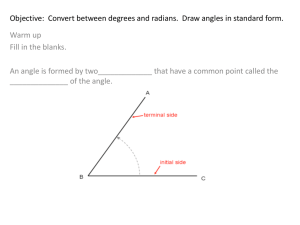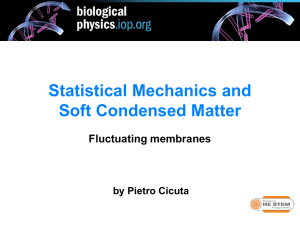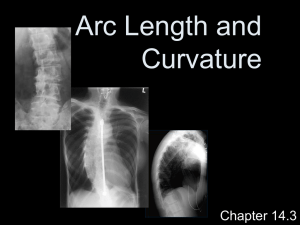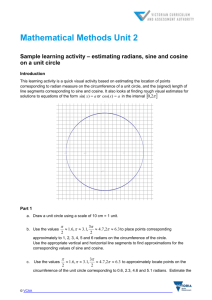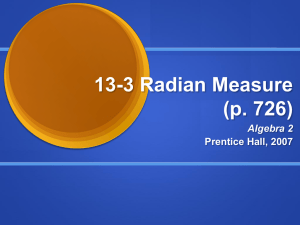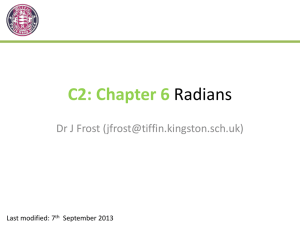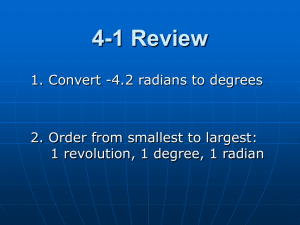cp07_envisioning_curvature_answerkey
advertisement
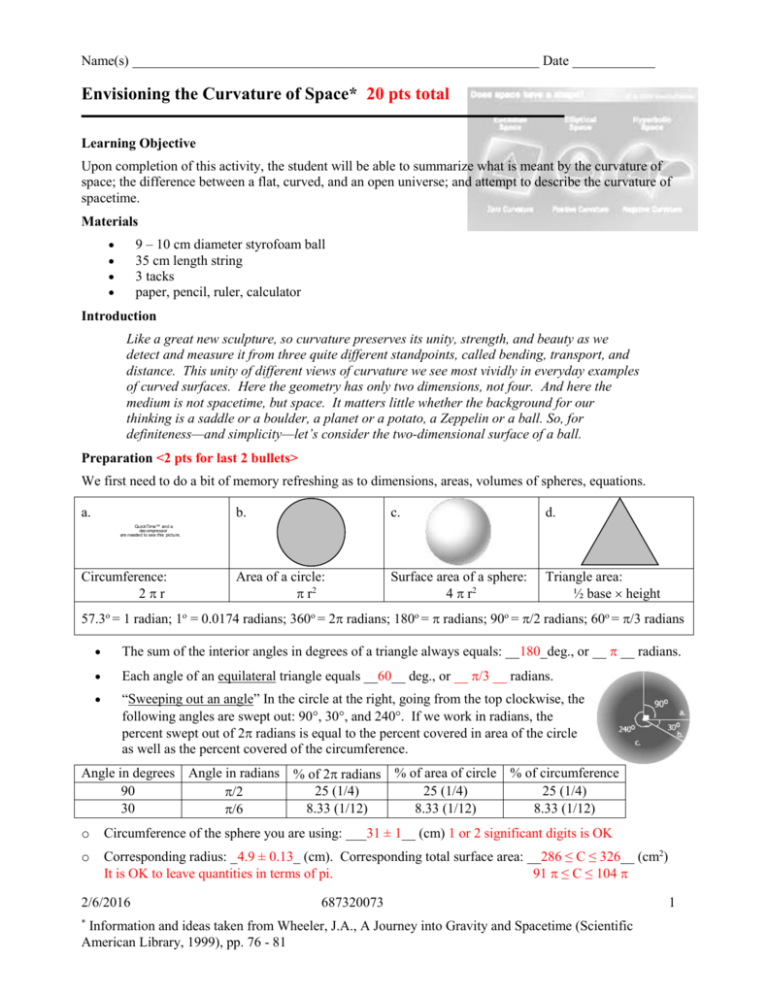
Name(s) ___________________________________________________________ Date ____________ Envisioning the Curvature of Space* 20 pts total Learning Objective Upon completion of this activity, the student will be able to summarize what is meant by the curvature of space; the difference between a flat, curved, and an open universe; and attempt to describe the curvature of spacetime. Materials 9 – 10 cm diameter styrofoam ball 35 cm length string 3 tacks paper, pencil, ruler, calculator Introduction Like a great new sculpture, so curvature preserves its unity, strength, and beauty as we detect and measure it from three quite different standpoints, called bending, transport, and distance. This unity of different views of curvature we see most vividly in everyday examples of curved surfaces. Here the geometry has only two dimensions, not four. And here the medium is not spacetime, but space. It matters little whether the background for our thinking is a saddle or a boulder, a planet or a potato, a Zeppelin or a ball. So, for definiteness—and simplicity—let’s consider the two-dimensional surface of a ball. Preparation <2 pts for last 2 bullets> We first need to do a bit of memory refreshing as to dimensions, areas, volumes of spheres, equations. a. b. c. d. Area of a circle: r2 Surface area of a sphere: 4 r2 Triangle area: ½ base height QuickTime™ and a dec ompressor are needed to see this picture. Circumference: 2r 57.3o = 1 radian; 1o = 0.0174 radians; 360o = 2 radians; 180o = radians; 90o = /2 radians; 60o = /3 radians The sum of the interior angles in degrees of a triangle always equals: __180_deg., or __ __ radians. Each angle of an equilateral triangle equals __60__ deg., or __/3 __ radians. “Sweeping out an angle” In the circle at the right, going from the top clockwise, the following angles are swept out: 90, 30, and 240. If we work in radians, the percent swept out of 2 radians is equal to the percent covered in area of the circle as well as the percent covered of the circumference. Angle in degrees Angle in radians % of 2 radians % of area of circle % of circumference 90 25 (1/4) 25 (1/4) 25 (1/4) /2 30 8.33 (1/12) 8.33 (1/12) 8.33 (1/12) /6 o Circumference of the sphere you are using: ___31 ± 1__ (cm) 1 or 2 significant digits is OK o Corresponding radius: _4.9 ± 0.13_ (cm). Corresponding total surface area: __286 ≤ C ≤ 326__ (cm2) It is OK to leave quantities in terms of pi. 91 ≤ C ≤ 104 2/6/2016 * 687320073 Information and ideas taken from Wheeler, J.A., A Journey into Gravity and Spacetime (Scientific American Library, 1999), pp. 76 - 81 1 Procedure Bending A. Take two tacks and place them on precisely opposite ends of the ball so that you have defined north and south. Using a piece of string or pen, mark a geodesic (a great circle) halfway in between the N and S poles to represent the “equator.” What is the circumference of your sphere in (measure in cm, please)? ___31 ± 1__ What is the corresponding radius? __4.9 ± 0.13___ cm B. Using two more tacks and the string, make an equilateral triangle on the ball (see figure at the right). <3 pts> o How many of these triangles could you make, centered on the north pole of the sphere, if none of them overlapped? ___4___ o How large is the angle at the N pole for one of the triangles in degrees? __90__ In radians? __/2___ o Since this is an equilateral triangle by design in curved space, what is the sum of the angles in degrees? __90+90+90 = 270___ In radians? __3/2__ Transport In this picture we see a person who always points due south. Walking from the north pole, he reaches the equator and immediately turns 90 degrees and walks some random distance due east, still pointing due south. After walking for a long while, he turns due north, but still points due south. The pointing direction is always directly south, and thus the person’s arm has not changed its direction angle at all, not one iota. This is called parallel transport. A. <1> However, when the person reaches the north pole after his trip, the arm is turned relative to its direction at the beginning of the trek. Is that angle of change in direction a) ___ greater than, b) X equal to, or c) ___ less than the angle “swept out” due to the distance the person traveled while at the equator? B. We can calculate the space curvature for this example. To find the change in direction and the space area circumnavigated, you need to figure out how much of the surface area of the sphere is enclosed by the person starting at the N pole, walking to the equator, turning 90 degrees east , walking a distance, turning 90 degrees north, and walking back to the N pole. The curvature of this sphere will be the same no matter what angle is swept out, right? Show all of your work below (use radians!). EXAMPLE: Let’s say that this person walks 1/6 of the way around the sphere at the equator. What is the angle change in direction that corresponds to that distance? Take 2 radians and multiply it by 1/6 and you get 2or /3 radians (60o). What fraction is this area of the total area of the sphere? Answer: 1/12. space curvature change in direction during parallel transport space area circumnavi gated o <1 pt>Curvature of your sphere = __~0.04___ radians per cm o [Bonus point +1] Show that the space curvature is just equal to the inverse of the radius squared. 3 1 4r 2 12 Example (chosen angle swept out may be different): 2 EQN. 1 2 3 12 1 2 2 4r r C. Consider another person walking on a very large flat plane, always pointing same direction, represented in the figure at the right by all of the arrows pointing south, and then coming back to the starting point. The person’s arm upon return is not turned relative to its direction at the beginning of the trek; however, obviously this person has swept out a non-zero angle. Conclusion for a flat plane: The angle of change in direction will always be a) ___ greater than, b) ___ equal to, or c) __X_ less than the angle “swept out” due to the distance the person traveled. Distance “Discrepancy in circumference reveals curvature!” A. What is the radius of your sphere again? __4.9 ± 0.13__ cm B. Divide the string in half twice so that it is one-quarter of the length it was. This shorter length represents ¼ of the sphere’s circumference. What is its length? ___7.5 to 8____ cm Fasten one end of this shortened string at the N pole, and loop a pencil through the other end. Draw a circle around the ball. It should match up exactly with the equator, right? You could use this shortened length of string to draw great circles all over the ball. C. That shortened length of string now represents the radius of the extension (not the projection) of the northern half of the 3-D sphere onto a 2-D plane! Take it, your pencil, and the piece of paper, and draw a circle. You will get a NEW circumference. What is the circumference of this flat circle? __ ~47 to ~50 __ cm D. <1 pt> For the value of the fractional circumference discrepancy, calculate the ratio of the radii (divide the sphere radius by the circle radius). ___ 0.64 _____ E. <1 pt> The space area responsible for the discrepancy is simply the area of the 2-D circle: _~177 to ~201_ cm2 F. We now estimate the space curvature from this “experiment,” by working with the sphere and the circle: space curvature fractional circumfere nce discrepanc y 4 space area responsibl e for discrepanc y EQN 2 2 Space curvature = __~0.045 to ~0.04__ radians per cm . How does your value for the space curvature calculated here compare to your previous calculation under parallel transport? They should be the same (within round-off errors), right? If they are more than a few percent off, check with your instructor. Even a brief comment works here. <1 pt> E. Cut out the circle from your flat piece of paper; mark the very center and pin it to the ball at the N pole. (You may choose to do this part as a thought experiment.) What would you have to do to get the circle to fit tightly over the ball? You can draw a picture if it helps to explain this. <1 pt> You would have to crinkle it up or cut out parts of it. It’s too big to fit tightly over the top of the sphere. QuickTi me™ and a decompressor are needed to see thi s pi ctur e. 3 It is hard to create a negatively (hyperbolic) curved space (saddle), and thus we will just state what the comparison of the circumference of a circle on the flat piece of paper and on a negatively curved space would give us: The negative curvature of this saddle would give us a longer circumference of a circle (given the same radius) than that of the flat space. While we keep that string taut when drawing our circle, we have to move up and down the saddle, and this lengthens the circumference. [This seems to be a concept often used in the design of amusement park rides.] Questions 1. <1 pt> Using information gained in this exercise, what is meant by “the curvature of space”? Sum of the angles of a triangle > 180 degrees; calculated positive space curvature under equations 1 & 2 Using definition of curvature as warping of space and time should be OK 2. <2 pts> How do these three curvature-of-space examples relate to the curvature of the Universe? Space may not be flat; there is curvature around objects with mass; space may be either open, closed, or flat. Positively curved space is closed; negatively curved space is open. LOOK for thought in answer. 3. <1 pt> Imagine a way to include the curvature of spacetime in this activity, or even just the curvature of time. What do you think? If you had all of the resources on Earth available to you, what would you do? Anything reasonable 4. <2 pts> The sum of the angles of a triangle in flat space is always 180 degrees. Is the sum of the angles of a triangle in positively curved space always 270 degrees, as you found for the equilateral triangle in the “bending” part above? Support your answer with an example (only one exception is needed to answer this question correctly). The sum of the angles of a triangle in positively curved space does not need to always be 270 degrees (as it was for equilateral triangles). For example, if we “swept out” an angle of only 30 degrees (/6 radians) then the sum would be 30 + 180 = 210 degrees. Here are spheres representing positively curved space with triangles having identical change-indirection angles. 5. <1 pt> Which sphere has the smallest curvature? _c_ 6. <1 pt> Using the equations above, what has changed to give it the smallest curvature? __ its radius________ c b a 7. <1 pt> What would be required to have the curvature of space equal to 0? Give an example of something that may have a curvature of 0. An extremely large radius! A plane, like a piece of paper. 8. <1 pt> What would be required to have the curvature of space go to infinity? Give an example of something that may have a curvature of infinity. An extremely small radius 0 (black hole) 4
